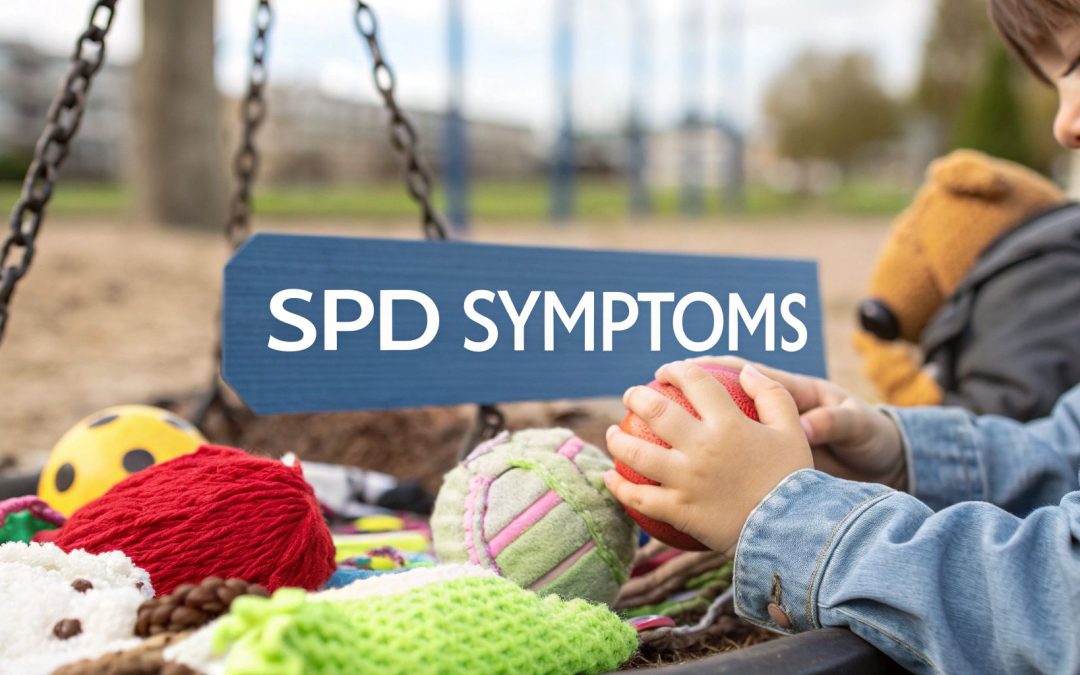Does your child’s behavior ever leave you feeling confused? Maybe it’s an extreme reaction to a loud sound, a meltdown over the tag on their shirt, or a constant, almost frantic need to be moving. These aren't just quirks or "bad behavior." Often, they're signs that the brain is struggling to organize and respond to information coming in from the senses. When that happens, everyday situations can feel completely overwhelming.
Understanding Sensory Processing Disorder in Your Child
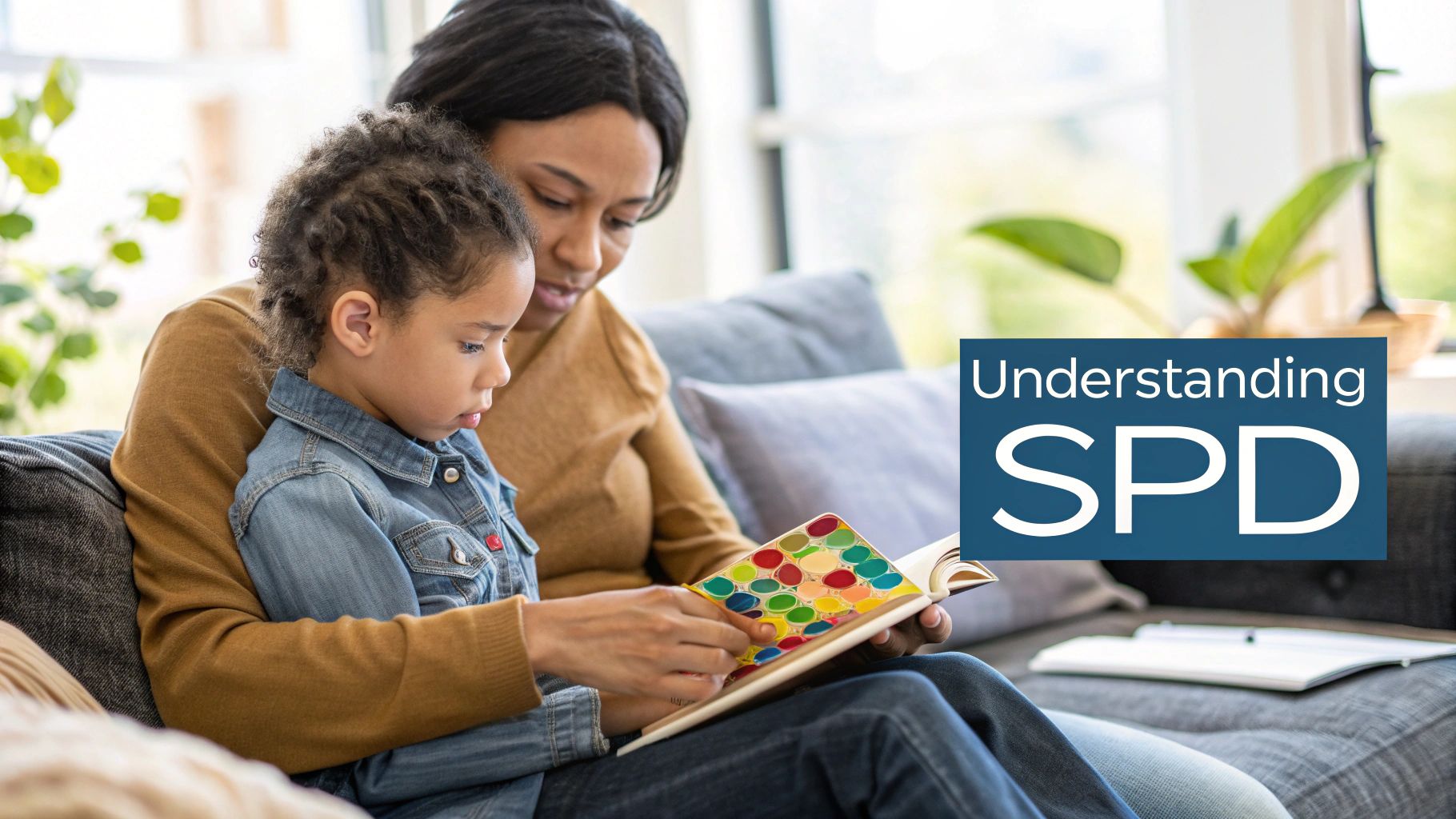
If you feel like your child experiences the world more intensely or just plain differently than their friends, you're not alone. What you might be seeing is Sensory Processing Disorder (SPD), a neurological condition that changes how the brain interprets sensory information.
Think of it like a traffic jam inside the nervous system. The signals from the senses—sight, sound, touch—get jumbled, delayed, or misinterpreted on their way to the brain. This neurological "traffic jam" is why a clothing tag can feel like sandpaper or the gentle hum of a refrigerator can be so distracting it’s impossible to concentrate.
It's so important to understand that these behaviors aren't intentional acts of defiance. They are genuine, physiological responses to a nervous system that’s having trouble organizing itself. Recognizing this is the first real step toward giving your child compassionate and truly effective support. To get a better handle on the basics, you can explore our complete guide on what is sensory processing disorder.
The Three Main Patterns of SPD
SPD isn't a one-size-fits-all condition. While many kids show a mix of traits, their challenges usually fall into one of three main patterns. Knowing these can help you start to pinpoint what's going on with your child.
Here’s a quick overview to make sense of these patterns.
The Three Main Patterns of SPD at a Glance
| Pattern of SPD | What It Looks Like in Simple Terms |
|---|---|
| Sensory Modulation Disorder | The child's "engine" is either running too high (over-responsive) or too low (under-responsive). They might also constantly seek out intense sensations to feel regulated. This is the most common pattern. |
| Sensory-Based Motor Disorder | This is a "body awareness" challenge. The child may seem clumsy, uncoordinated, or have trouble with balance and posture (dyspraxia). |
| Sensory Discrimination Disorder | The brain struggles to "fine-tune" sensory details. A child might not be able to tell the difference between a dime and a quarter in their pocket just by feel. |
Each of these patterns can look very different from one child to the next. For some, it's extreme sensitivity to sound and touch. For others, it’s poor motor skills or being easily distracted.
And this is far from rare. Research suggests that 5 to 16 percent of school-aged children experience symptoms significant enough to impact their daily lives. These challenges are very real, and understanding them is the key to helping your child thrive. You can read more research findings about sensory dysfunction to see just how common these hurdles are.
Exploring the Eight Senses That Shape Their World
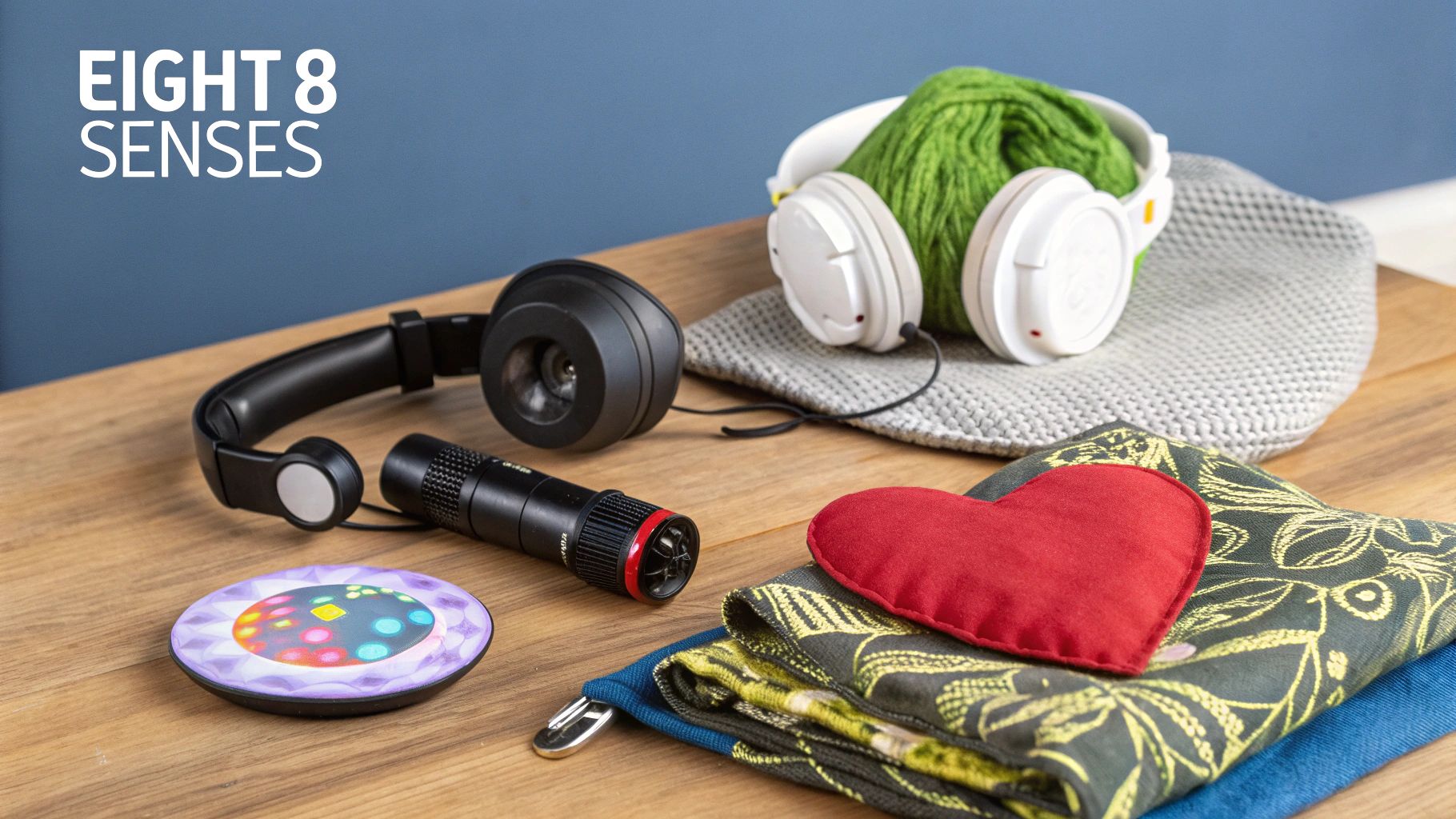
To really get to the heart of sensory processing disorder symptoms, we have to look beyond the classic five senses. Of course, sight, sound, smell, taste, and touch are a huge part of how we experience life. But our bodies also have three other "hidden" senses working tirelessly behind the scenes.
These internal systems are what shape how we move, how we feel inside our own skin, and how we interact with everything around us. When one of them isn't processing information quite right, it can lead to some of the confusing behaviors you might be seeing. Getting a handle on all eight senses is the first real step to connecting your child's actions to their underlying neurological needs.
The Five Familiar Senses
We all learned about the big five in school. But for a child with SPD, the information coming in through these channels can feel scrambled, amplified, or completely muted.
- Tactile (Touch): How we interpret everything from a soft blanket to a sticky countertop—pressure, texture, temperature, and pain.
- Auditory (Hearing): The way our brain processes sounds, from the quietest whisper to a sudden, loud alarm.
- Visual (Sight): Making sense of a busy classroom, bright lights, colors, and movement.
- Olfactory (Smell): Our ability to process and react to the millions of different scents in our environment.
- Gustatory (Taste): How we interpret flavors and food textures, from sweet and sour to spicy or mushy.
For a child struggling with sensory processing, a gentle pat on the back might feel like a startling push. The quiet hum of a refrigerator could be so distracting that it drowns out a parent's voice. Their symptoms are a direct result of how their brain is trying to make sense of all this incoming data.
The Three Hidden Senses
This is where so many of the challenges with SPD originate. Beyond the familiar five, three powerful internal senses play a massive role in a child's coordination, emotional regulation, and overall development.
First up is the vestibular system, which is located in our inner ear. You can think of it as the body’s internal gyroscope. It's in charge of our sense of balance, movement, and where we are in space. It’s what tells us if we’re moving or still, right-side up or upside down. A kid who is constantly spinning in circles, or on the flip side, is terrified of the playground swings, might have a disorganized vestibular system.
Next, we have the proprioceptive system. This sense gets its information from receptors in our muscles and joints. It’s our body awareness sense—kind of like the brain's internal GPS. Proprioception is how you can touch your nose with your eyes closed or navigate a dark room without bumping into the furniture. A child who crashes into things, plays way too roughly, or is always chewing on their shirt collar may be seeking intense proprioceptive input just to feel grounded and secure in their own body.
Finally, there's the interoceptive system. This is our awareness of what's happening inside our bodies. It’s the sense that tells us we are hungry, thirsty, tired, too hot, or need to use the bathroom. A child with poor interoceptive awareness might not recognize these crucial body cues, which can lead to sudden, explosive meltdowns that seem to come from nowhere—when really, they were just desperately hungry and didn't realize it.
Understanding these hidden senses is absolutely crucial for decoding your child’s unique needs and behaviors.
Identifying Sensory Over-Responsive Symptoms
For some children, the world feels like it's perpetually stuck on the loudest, brightest setting. Everyday sensations most of us barely notice can feel intense, overwhelming, and even physically painful. This is the reality of sensory over-responsivity, often leading to what's called sensory "avoiding."
Think of their nervous system as an ultra-sensitive microphone that picks up every pin drop, making it nearly impossible to focus on the main conversation. These kids aren't trying to be difficult; their brains are genuinely struggling to manage a flood of incoming information. This can trigger a fight, flight, or freeze response in situations that seem totally normal to everyone else. Learning to spot the specific symptoms of sensory processing disorder is the first step toward understanding their world and giving them the right support.
Common Signs of Over-Responsivity by Sense
To help you connect the dots, let's break down the common behaviors you might see when a particular sensory system gets overloaded.
- Auditory Symptoms: A child might clamp their hands over their ears at the sound of a vacuum cleaner, hand dryer, or passing siren. Noisy places like birthday parties or school assemblies can cause visible distress.
- Tactile Symptoms: They might be incredibly picky about clothes, complaining that tags are "too itchy" or that the seam on their sock feels "bumpy." Many also hate messy play, recoiling from the feeling of finger paint, mud, or glue on their hands.
- Visual Symptoms: The bright, flickering fluorescent lights in a supermarket might be completely disorienting. They can also get overwhelmed in visually cluttered rooms or become easily distracted by movement in their peripheral vision.
This infographic shows just how frequently over-responsive symptoms show up across the most commonly affected sensory systems.
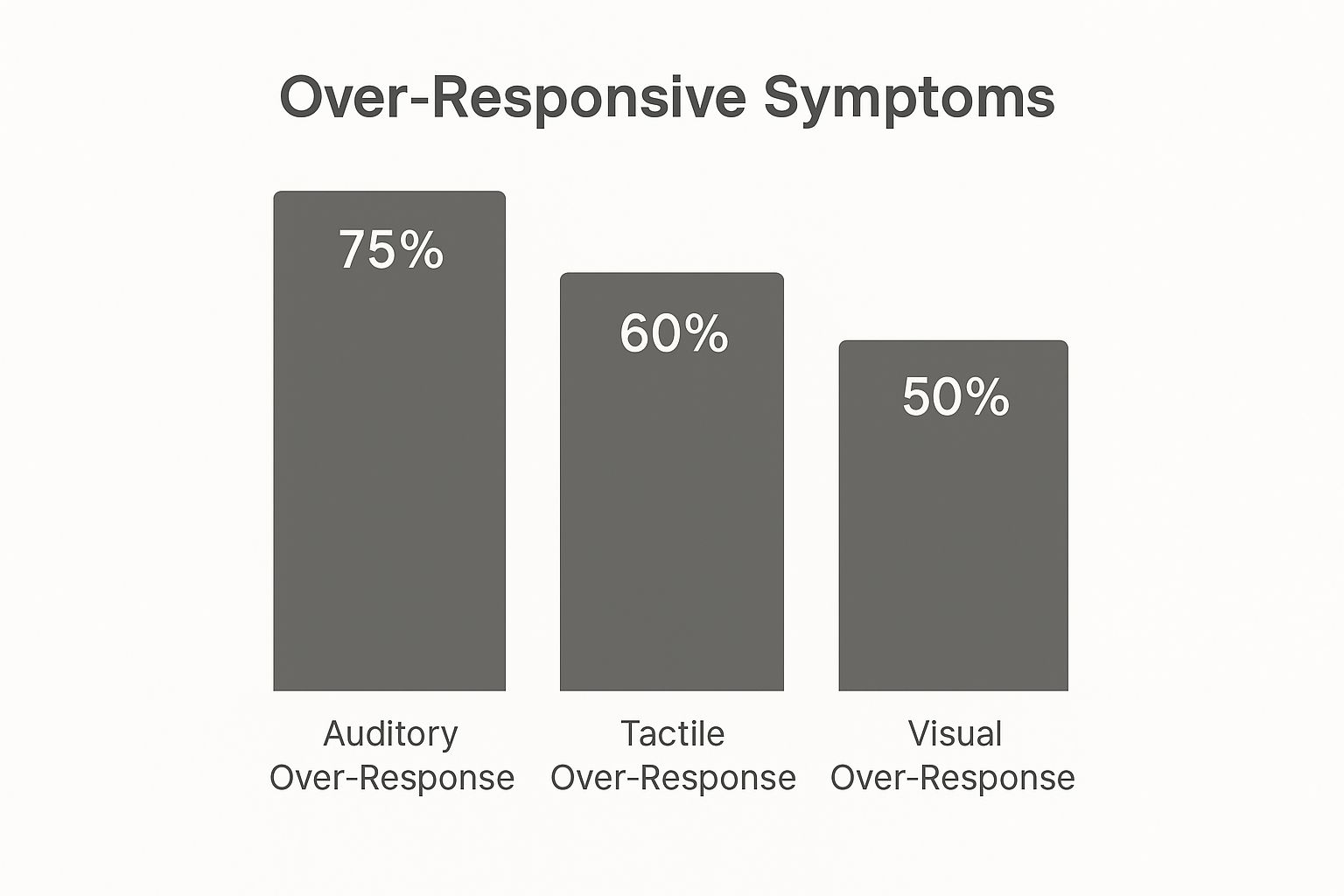
As the data makes clear, sensitivities to sound and touch are especially common challenges for children with over-responsive sensory profiles.
Movement and Body Awareness Red Flags
Beyond the five senses we all know, over-responsivity can also throw a wrench into a child’s relationship with movement and their own body in space.
A key red flag for vestibular over-responsivity is a deep-seated fear of movement, something experts call gravitational insecurity. This is the child who is terrified of playground swings, avoids having their feet leave the ground, or panics when tilted backward to get their hair washed.
Here are a few other movement-related symptoms to watch for:
- Vestibular (Balance): Besides hating swings, they might get carsick very easily or feel dizzy after just a little bit of spinning. You'll often see them choosing quiet, sedentary activities where they can feel stable and grounded.
- Proprioceptive (Body Awareness): They may really dislike roughhousing or pull away from tight hugs. For them, that deep pressure input can feel invasive and alarming rather than comforting.
Noticing these patterns isn’t about slapping a label on your child. It's about gathering clues. When you start to see a consistent pattern of avoidance across different senses and situations, it's a strong signal that their nervous system needs a little more support to feel safe and regulated in the world.
Recognizing Under-Responsive and Sensory Seeking Behaviors
While some children are overwhelmed by the world, others seem to barely notice it at all. This is the other side of the sensory processing coin: under-responsivity.
Think of their nervous system not as an overly sensitive microphone, but as a radio with the volume turned way down. They need much more intense, frequent, or long-lasting sensory input just to register what's happening and feel "just right."
This constant need for more input often drives what we call sensory-seeking behaviors. A child who is always moving, touching everything in sight, making loud noises, or crashing into furniture isn't trying to be disruptive. They are actively trying to "wake up" their nervous system to get the feedback their brain is desperately craving.
These actions are purposeful, even if they look chaotic to us. Understanding this is the key to shifting our perspective from one of discipline to one of support.
Common Signs of Under-Responsivity and Seeking
Let’s break down what these behaviors look like across different sensory systems. It's common for a child to have a mix of these traits, as their sensory needs can be pretty complex.
-
Proprioceptive Seeking: This is one of the most common profiles we see. These kids often seem to have a bottomless well of energy. They might stomp their feet when they walk, crash onto the couch with a thud, give bone-crushing hugs, or constantly chew on their shirt collar or pencils. What they're really after is deep pressure and heavy work for their muscles and joints.
-
Vestibular Seeking: A child seeking vestibular input is the one who could spin in circles forever and never seem dizzy. They adore swinging as high as possible, hanging upside down, and are drawn to the very amusement park rides that others find terrifying. They are perpetual motion machines, often rocking, fidgeting, or running instead of walking.
A key takeaway is that these behaviors are not hyperactivity in the traditional sense. They are a child's intuitive attempt to self-regulate by feeding their nervous system the intense input it needs to function.
- Tactile Seeking: This often looks like a need to touch everything and everyone. These children might play with their food, love messy play with mud or slime, and prefer to walk barefoot. They often don't seem to notice if their face is messy or their hands are covered in dirt.
Comparing Sensory Responses: Over-Responsive vs Under-Responsive
It can be confusing to see such opposite reactions to sensory input. One child might recoil from a hug, while another seeks out the tightest squeeze they can get. This table helps clarify the differences between an over-responsive (avoiding) child and an under-responsive or seeking (craving) child.
| Sensory Input | Over-Responsive Reaction (Avoids) | Under-Responsive or Seeking Reaction (Craves) |
|---|---|---|
| Touch | Dislikes messy hands, avoids hugs, bothered by clothing tags. | Loves messy play, touches everything, unaware of food on face. |
| Movement | Fears swings, gets carsick easily, prefers sitting still. | Loves spinning and heights, constantly fidgets or runs. |
| Sound | Covers ears at loud noises, easily distracted by background sounds. | Makes loud noises, enjoys noisy places, may not respond to name. |
| Oral Input | Is a very picky eater, dislikes certain food textures. | Chews on non-food items, prefers intensely flavored or crunchy foods. |
Seeing these distinct patterns is the first step toward providing the right kind of support. Instead of trying to stop the behavior, our goal becomes finding safe and appropriate ways for your child to get the sensory input their body and brain need to feel calm, organized, and ready to take on the world.
How SPD Symptoms Evolve as Your Child Grows
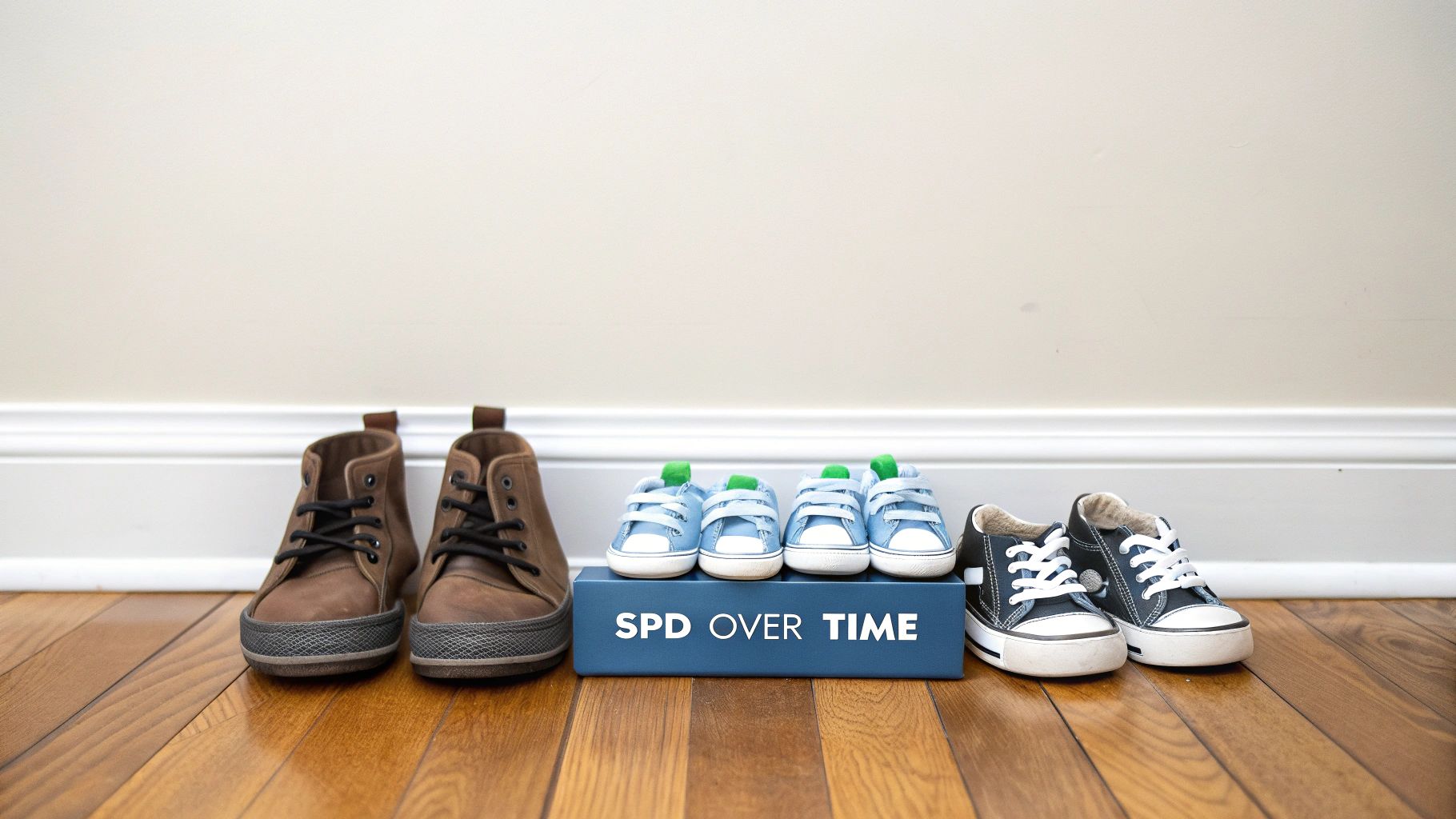
Sensory processing challenges are not static. They shift and change as a child’s brain develops and the world around them becomes more complex. The sensory struggles you see in a toddler will look very different from those faced by a teenager, which is why understanding this evolution is key to providing the right support at every stage.
When you can recognize how sensory needs present from infancy all the way through the teen years, you can better anticipate hurdles and celebrate successes. This developmental context helps turn confusing behaviors into clear signals, empowering you to respond with compassion to your child's unique journey.
Symptoms in Infants and Toddlers
In the earliest years, signs of a sensory processing disorder often show up around core developmental tasks like feeding, sleeping, and bonding. An infant’s nervous system is just learning to organize a constant stream of new sensations, and for some, this process is incredibly difficult.
You might notice signs like:
- Extreme irritability when being dressed, bathed, or having their diaper changed.
- Resisting cuddling or arching their back away from touch, seeming inconsolable for no clear reason.
- Significant feeding challenges, such as gagging on new textures or struggling to latch.
- Unusual passivity, appearing "floppy" and showing little interest in exploring toys or their surroundings.
As they grow into toddlers, these challenges can evolve. A toddler with sensory issues might have explosive meltdowns during transitions, show an unusually high or low tolerance for pain, or engage in constant, almost frantic, movement. These are all early indicators that their nervous system is struggling to find a state of balance.
Red Flags in Preschool and School-Aged Children
Once a child enters preschool and elementary school, the social and academic demands increase dramatically. Sensory challenges that were manageable at home can quickly become significant obstacles in a busy, structured classroom.
During this stage, SPD symptoms often manifest as behavioral or learning difficulties. For instance, a child who is under-responsive to auditory input may be labeled as "not listening," when in reality, their brain isn’t effectively processing the teacher's voice. Another child, overwhelmed by the visual clutter and noise of the classroom, may act out simply to escape the sensory flood.
Sensory challenges in school-aged kids frequently impact social skills. A child who avoids touch may struggle to stand in line, while one who doesn't understand personal space might seem overly aggressive during play, leading to difficulties making and keeping friends.
Some of the most prominent signs in this age group include:
- Difficulty with fine motor skills like holding a pencil or using scissors.
- Appearing clumsy, uncoordinated, or accident-prone.
- An inability to sit still during circle time or at a desk.
- Extreme emotional reactions to seemingly minor events.
Many of these actions can be traced back to sensory seeking behaviour, where a child's nervous system is actively trying to get the input it needs to feel organized. Research shows that sensory issues are quite common, with studies reporting prevalence rates from 5% to as high as 16% in school-aged children. This highlights just how many kids are navigating these invisible hurdles. You can explore the full research on sensory dysfunction prevalence to better understand the scope of these challenges.
Challenges for Teenagers
As children enter the teen years, sensory issues often become more internalized. While the underlying neurological differences remain, the symptoms may look more like anxiety, social withdrawal, or difficulties with executive functions like planning and organization.
A teenager with SPD might:
- Feel constantly exhausted from the effort of navigating social situations.
- Avoid crowded places like school hallways, the cafeteria, or pep rallies.
- Struggle to focus on homework amidst background noise at home.
- Have difficulty managing their schedule, belongings, and time.
These challenges can significantly impact a teen's self-esteem and mental health. By understanding the sensory root of these difficulties, parents and educators can provide more effective support—like creating quiet study spaces or allowing the use of noise-canceling headphones—helping them build the skills and confidence needed to thrive.
Taking the Next Steps and Finding Support
Recognizing the patterns of sensory processing disorder in your child is a massive breakthrough. It’s the moment when confusion starts turning into clarity, letting you move from a place of worry to one of empowered action. The next step is to get professional guidance to find the right support for your family’s unique journey.
This is where an occupational therapist (OT), especially one who specializes in sensory integration, becomes your most trusted partner. OTs are trained to see exactly how sensory challenges are impacting daily life. They create practical, often play-based, strategies to help your child’s nervous system get more organized and build resilience.
When to Seek an Evaluation
If you're seeing consistent clusters of symptoms that get in the way of daily routines, it's a good idea to seek an evaluation. You should consider reaching out to a professional if your child is frequently showing signs across a few different areas.
- Emotional and Social Impact: Does your child have intense, frequent meltdowns triggered by sensory input? Do they struggle to make friends because they avoid touch or don't seem to understand personal space?
- Daily Functioning Hurdles: Are there significant challenges with simple things like getting dressed, eating a variety of foods, or taking a bath? Does your child just barely tolerate the school environment?
- Safety Concerns: Does your child engage in intense sensory-seeking behaviors, like crashing into things or climbing to dangerous heights without a real sense of risk?
It’s incredibly helpful to document what you’re seeing. Before an appointment, try jotting down specific examples of behaviors. Note what happened right before and after. This gives the therapist a clear, detailed picture of your child’s daily experiences.
It's also important to know that sensory challenges often go hand-in-hand with other conditions. Globally, atypical sensory processing affects around 39.7 percent of children with neurodevelopmental disorders, making these difficulties a significant issue that deserves clinical attention. You can read the full research on this connection to get a better sense of the bigger picture.
Finding the right support path can make a world of difference. Exploring options like specialized sensory processing disorder therapy provides targeted interventions that build confidence and improve your child's overall well-being. An assessment will give you a clear roadmap, turning uncertainty into a plan you can act on.
Common Questions About Sensory Processing in Children
As you start connecting the dots between your child's behaviors and their sensory world, a whole new set of questions is bound to pop up. It’s a journey to fully grasp the nuances of sensory processing, so let’s clear up a few common points of confusion and give you some extra reassurance along the way.
Can a Child Be Both a Sensory Seeker and Avoider?
Yes, absolutely. This is one of the most common things we see, and it’s often called a "mixed sensory profile." It might seem like a contradiction, but it makes perfect sense when you think about how a child's nervous system can be over-responsive in some areas and under-responsive in others.
A great example is a child who craves the intense motion of swinging as high as humanly possible (that’s vestibular seeking) but has a complete meltdown over the loud roar of a hand dryer (that's auditory avoiding). These needs can even shift day by day—or even hour by hour—depending on their environment and how regulated they feel on the inside.
Is Sensory Processing Disorder the Same as Autism?
This is a big one. While SPD and autism are closely related and often overlap, they are not the same thing. It's true that many individuals on the autism spectrum face significant sensory challenges; in fact, sensory sensitivities are now part of the diagnostic criteria for autism.
However, it's entirely possible to have SPD without having autism.
Think of it this way: Sensory Processing Disorder is a standalone condition that zeroes in on how the nervous system takes in and makes sense of sensory information. The only way to know for sure is through a comprehensive evaluation from a qualified professional, like an occupational therapist or a developmental pediatrician.
What if My Doctor Dismisses My Concerns?
First off, it is incredibly disheartening when you feel like you aren't being heard. But I want you to remember this: you are the expert on your child. If your gut tells you something is going on and your pediatrician isn't familiar with SPD, please don't give up.
You can always seek a second opinion, perhaps from a developmental pediatrician who specializes in this area. Or, you can go directly to an occupational therapist (OT). OTs are the primary professionals who assess and support kids with sensory challenges, and in many places, you don’t even need a doctor’s referral to schedule that first conversation.
At First Steps Chiropractic, we get to the root cause of these challenges by looking at how the nervous system is functioning. When the nervous system is balanced, it's far better equipped to process all that sensory information, helping your child feel more calm, organized, and in control.
Learn how our gentle, neurologically-focused approach can support your family. You can explore our services right here: https://firststepschiropractic.com.

